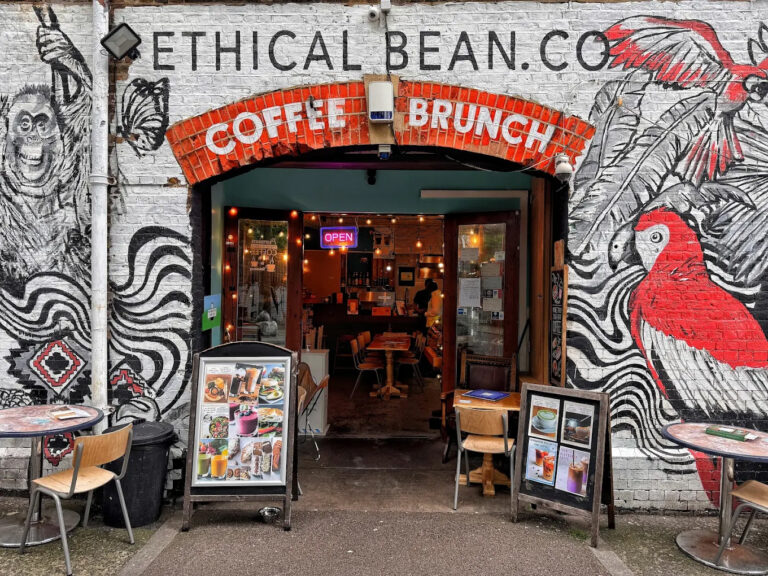
Review: Kokin – tuna meets fire at The Stratford
The new sushi restaurant now at the iconic skyscraper’s 7th floor and terrace
From illegal-squat raves and graffiti to repurposed derelict buildings, Hackney Wick’s history is written on its streets. And while the near weekly-opening of new businesses, coupled with the hordes of ‘tourists’ might appear to bring a sanitisation of the area, one local organisation is hoping to steer the neighbourhood towards a new unique future.
The Hackney Wick and Fish Island Community Development Trust (CDT), an organisation originally set up in 2017 by four local social enterprise businesses, was recently successful in the first round of the Greater London Authority’s High Street for All Challenge. The scheme secures funds to design an innovative high street, awarding £20,000 to present a full bid in November.

This formerly industrial district has never had a traditional high street, and the CDT is embracing that in its designs; the vision connects a corridor of existing businesses, creating a new ‘circular high street’ with a focus on the existing yards. In this sense, the CDT hopes that the model will serve as an innovative example for the UK.
Paul Reynolds, Director of the CDT and Tapestry, the firm tasked with the design explains that Hackney Wick is particularly well placed to deliver a 21st century high street. “Nationally we’re seeing a shift away from high streets being about product consumption and it’s more about experience.” Reynolds, who is on the UK High Streets task force, adds that this trend “actually kind of suits Hackney Wick, the kind of place it is and why it’s always been here.” He adds that the trend towards pop-up markets, which are common here, is especially good for including young people due to their informal nature and low barriers to entry.
In many ways, the physical high street is a metaphor for a larger process of integrating the various communities within Hackney Wick and Fish Island, including warehouse-creatives, new-build residents, Trowbridge Estate residents and other groups; the CDT is using much of the £20,000 to fund youth engagement.

Beyond that, the CDT hopes that the high street will be a step towards making Hackney Wick a hub for sustainability (see p.6). Alex Russell, executive chair of the CDT claims that sustainability can serve as a common ground for the diverse communities in the area. “We’re getting people around the table who haven’t sat there before,” says Russell. “It’s quite difficult to find any topic that everybody agrees on, but actually the concept of having a cleaner environment, less waste, that’s one that everyone can get behind.”
Sabinna Rachimova, who runs the local sustainable fashion brand Sabinna, agrees with Russell’s focus. For her, bringing different communities together is key towards creating a local microeconomy. “This will encourage collaboration, which is a great opportunity.” With UAL and the V&A opening campuses nearby, Hackney Wick is posed to be a leader in innovation in the arts and cultural worlds; Sabinna, who also lectures at the London College of Fashion and runs workshops and podcasts on circular economies, hopes the area can become an incubator for young talent, and lead a revolution in sustainability in the process. But she cautions against focusing too much on developing businesses and institutions at the expense of local residents. “We do need to talk about negative gentrification when we talk about new economic developments,” she warns.
New residential developments, which Reynolds calls “a fairly standard product”, do not necessarily contribute to the area’s economic inclusivity, character, or environmental sustainability. “These new flats with 99-year leaseholds are designed to decay within or just after they reach that point. They will forever be what they are and cannot be creative spaces,” says Tom Fletcher, of Fish Island-based Rejuce (see also p.6).


It’s Hackney Wick’s warehouse community, which has been here for over two decades, that has breathed new life into formerly industrial spaces. In addition, shared living allows for resource sharing and bundles the fixed costs associated with conventional 3-4 bedroom houses.
Hackney Wick has never been a traditional place, and so has never had anything resembling a traditional high street. What it has had, however, is a unique and thriving arts scene which has challenged many of the orthodoxies around the economy and sustainability. Through the sea of new markets now occurring in the Wick, residents are finding ways to sell their crafts without the high barriers to entry of traditional retail space. At a time when the classic high street model seems increasingly obsolete, this area stands well-poised to deliver a strong vision of the retail future. But in order to deliver a truly unique and innovative high street, the CDT must not lose sight of its roots; it must foster and harness the grassroots creative potential of the area’s communities; the DIY culture which has made Hackney Wick so attractive in the first place.

The Hackney Wick Community Development Trust would like to hear from young people who care about the future of the area and would like to join a group that will be paid to lead public engagement and shape the project. They are also keen to speak to businesses and organisations working on environmental sustainability and circular economy who would be keen to share their learning and understanding. Alex Russell can be contacted at alex@wickcdt.org


The new sushi restaurant now at the iconic skyscraper’s 7th floor and terrace

Exploring the health advantages of belonging to something bigger than ourselves

Your timely reminder to go visit these amazing restaurants, bars and cafes this summer while we wait for better bridge access…
A joint venture in collaborative local media from:


In partnership with

Regulated by IMRESSS, the Independent Monitor for the Press CIC.
For more info on our complaints policy, or to make a complaint, visit FAQ.
